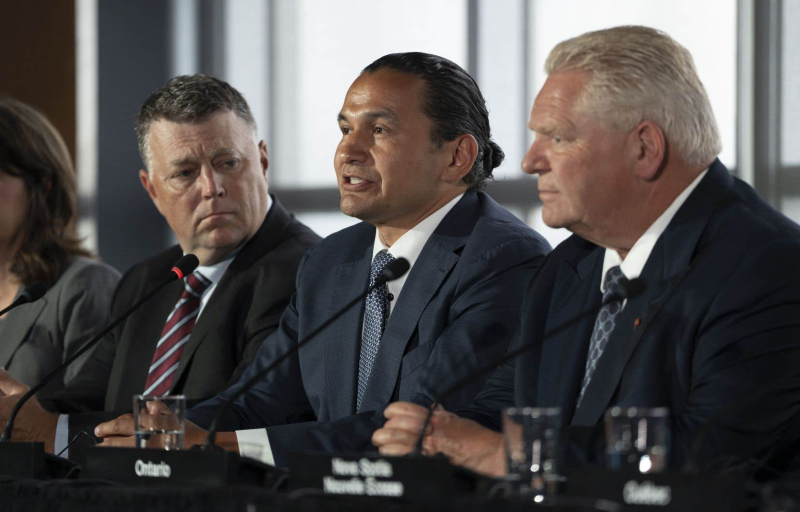
Photo: Darren Calabrese The Canadian Press Manitoba Premier Wab Kinew (centre) at a news conference to close the Council of the Federation on Wednesday in Halifax, alongside Prince Edward Island Premier Dennis King (left) and Ontario Premier Doug Ford (right)
Patrice Bergeron – The Canadian Press in Halifax
Published at 6:29 p.m.
- Canada
The call for help launched by François Legault to other provinces to welcome asylum seekers arriving in Quebec was partly heard.
Manitoba raised its hand on Wednesday to receive it, as did other provinces, demanding financial assistance from the federal government, but we are not rushing to help Quebec.
For several months on all platforms, Prime Minister Legault has deplored that Quebec welcomes practically half of the asylum seekers in the country, while its demographic weight in the country is equivalent to 22% .
There were 190,000 in Quebec in the second quarter of this year. Immigration is a jurisdiction shared between Quebec and Ottawa, but it is the federal government that is in charge of asylum seekers.
“We would be willing to welcome newcomers, especially from the French-speaking world,” Manitoba Premier Wab Kinew said at the closing news conference of the Council of the Federation meeting in Halifax until Wednesday.
But he did not say how many might come to settle in Manitoba.
He said his province needs help from the federal government to build more affordable housing and better fund health services.
“If the federal government is there to help us, we might be able to work with either Quebec or the other provinces to improve this situation.” “
Newfoundland and Labrador Premier Andrew Furey has also suggested that his province is prepared to accept a number of asylum seekers that corresponds to its proportion of the population in the Canadian federation.
“Maybe Newfoundland and Labrador doesn't take in as many as it should,” he mused.
Furthermore, provinces also gnashed their teeth since Ottawa paid $750 million to Quebec to cover the costs generated by welcoming asylum seekers.
“This It's not fair that Quebec receives this amount and not the other provinces, recognized Mr. Legault. I would prefer to receive less money and receive fewer asylum seekers. »
Asked to comment and indicate how many asylum seekers they would be prepared to receive, other prime ministers were much more vague. Ontario and Alberta have suggested they are already doing their part.
Alberta Premier Danielle Smith said her province represents 12% of Canada’s population but receives 22% of total immigration to the country, a calculation that takes into account more than just asylum seekers.
“We want to do our part, but it puts pressure on housing, […], education,” she argued.
For his part, her Ontario counterpart, Doug Ford, also pointed out that the massive reception of new arrivals, including thousands of asylum seekers each month, costs his government $1 billion per year, while it only receives $162 million from the federal government.
He is demanding that the federal government process work permit applications more quickly rather than parking applicants in hotels waiting.
“It's heartbreaking,” he said.
New Brunswick Premier Blaine Higgs also argued that his province already welcomes many immigrants.
In particular, he calls for more clarity and consistency from the federal government in the admission and selection of new arrivals.
“We must find the balance [between the reception of immigrants] and the construction of new housing”, he affirmed.
The day before, François Legault had succeeded in obtaining a common front from the provinces: they are all demanding at the federal level a “fair distribution” and “control” of asylum seekers based on the capacity of each province and territory to provide housing and services.
Au second quarter of this year, according to Statistics Canada, Quebec welcomed a total of 597,000 non-permanent residents, already 47,000 more than the previous quarter. For comparison, in the second quarter of 2023, there were 421,000.
“We are not able to integrate these people, we lack housing, we lack staff, many are in Montreal and do not speak French,” lamented Mr. Legault on Tuesday.
In the total non-permanent residents, there are 190,000 asylum seekers and 407,000 work and study permit holders, and their family members.
Under a Canada-Quebec agreement signed in 1991, Quebec controls the volume of entry of its future permanent residents, economic immigrants, as well as their integration and Frenchization. Economic immigration represented 66% of permanent immigration in 2022.
The federal government deals with refugees, family reunification and citizenship issues .
Quebec can receive a percentage of total immigrants arriving in Canada that is equivalent to the proportion of its population within the federation. Currently, the demographic weight of Quebec is approximately 22.3% of the Canadian population.
Federal Prime Minister Justin Trudeau had already said that the Quebec had the “full capacity” to welcome 112,000 immigrants per year, therefore a little more than 22% of the target of 500,000 permanent immigrants that its government wants to welcome per year by 2025.

